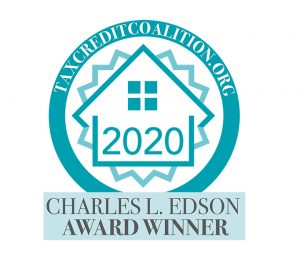The Whittier Street Apartments opened in 1953, a brand new 200-unit public housing community in Lower Roxbury. Within ten years of its opening, the surrounding neighborhood had been leveled to make way for two new interstate highway projects: an extension of the north-to-south I-95 and a new “Inner Belt” I-695, proposed to divert traffic away from and around downtown. The planned interchange for the two new highways was to be immediately adjacent to Whittier Street. A process of land assemblage ensued, with the City and State accumulating and clearing significant swaths of land for the projects.

Original Whittier Street Apartments
In the face of intense and well organized community opposition to the proposed highway projects, the governor of Massachusetts announced a moratorium on highway construction within the core metropolitan area in the early 1970s—but not before hundreds of homes, businesses and churches had already been demolished in Lower Roxbury. Large parcels of vacant land were left, creating a 40-year legacy of blight and abandonment in the neighborhood. Rampant arson in the 1970s surrounding Dudley Square added to the neighborhood decline and left more sites vacant and abandoned.
In the decades since the highway projects were canceled, the community has advanced its own vision and its own plan for rebuilding. The Lower Roxbury Community Corporation, one of the nation’s first community development corporations, renamed itself Madison Park Development Corporation to stake claim to the cleared land in and around the historical Madison Park between Whittier Street and Dudley Square. In the 1980s, the City of Boston built Melnea Cass Boulevard, a four-lane thoroughfare named for a local activist, connecting I-93 and Columbus Avenue. The Commonwealth of Massachusetts relocated the Orange Line rapid transit service to the Southwest Corridor right-of-way along Columbus Avenue that was originally cleared for I-95.
The Whittier neighborhood is roughly one square mile, with a population of 6,391 residing in 2,418 households. Racially and ethnically, the neighborhood is significantly more diverse than the city or the region, with 59% Black or African American and 34% Hispanic or Latino. The population is also younger, with almost 30% of residents under the age of 20, compared with 21% citywide. Female-headed households predominate at 63% compared to the city average of 16%.
The Whittier neighborhood is rich in amenities and is home to some of Boston’s anchor educational, civic and cultural institutions. Yet the underlying story of the Whittier neighborhood is the chronic struggle of the majority of its residents, who are among the poorest in Boston. In December 2016 HUD awarded a $30 million Choice grant to support safe streets, better access to quality educational and job opportunities that promote family self-sufficiency
Excerpts taken from the Whittier Transformation Plan
